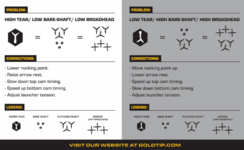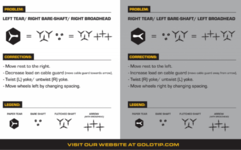So I have a slight right tear in a RX-1. I read the 2018 Hoyt technical document attached in the link below. On page 3, nubmer 4 it says :
Cable side “Main body buss cable yoke” can be twisted up to reduce right tear but the cam should not be stood up past vertical.
This is where I was hoping for clarification. Does this mean to put a twist in the main body buss cable by adding to a twist in the top of that and not with the yokes? I wanted to try this before removing the exact grip. Any insight is greatly appreciated.
Cable side “Main body buss cable yoke” can be twisted up to reduce right tear but the cam should not be stood up past vertical.
This is where I was hoping for clarification. Does this mean to put a twist in the main body buss cable by adding to a twist in the top of that and not with the yokes? I wanted to try this before removing the exact grip. Any insight is greatly appreciated.






